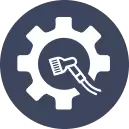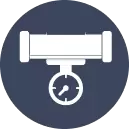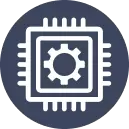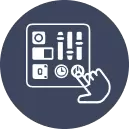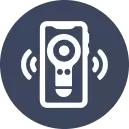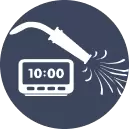Automation is built upon controllers and sensors. They monitor conditions and make decisions based on data to keep machines and devices up and running.
What Are Controllers?
Controllers are the brain of an automation system. They analyze information and make decisions based on data on various sources.
Types of Controllers
Different tasks require different forms of controllers. Each was purpose-built for a specific kind of work.
- Programmable Logic Controllers (PLCs): Common in factories, and large systems PLCs operate multiple processes simultaneously and in harsh environments. They also keep the production lines running smoothly.
- Microcontrollers: Small circuits are behind everyday devices and hobby projects. They're simple to use and designed for bespoke applications.
- Distributed Control Systems (DCS): This type of system is spread over several sectors. They are used in large plants where multiple processes need to be controlled at once.
- Embedded Controllers: Embedded controllers are embedded into smart devices and IoT systems. They operate in real time and execute specific tasks to manage equipment.
Key Features of Controllers
Modern controllers are characterized by reliability and versatility.
- Real-Time Processing: They can compute and decide during their actions, an important characteristic that is vital for safe and optimized task completion.
- Scalability and Flexibility: Controllers can be used in tiny devices or enormous factories. They are programmed to certain needs too.
- Robustness: They are tested anywhere from extreme temperatures to vibrations to electrical interference.
- Connectivity: The controllers work wirelessly or via the internet, making it easy for them to talk to other devices so they can be monitored and controlled from a distance.
What Are Sensors?
Sensors are the eyes and ears for a system. They record various physical states and communicate that information to controllers.
Common Types of Sensors
There are several types of sensors to monitor the conditions. Here are a few common ones:
- Temperature Sensors: These are sensors that detect heat. They are also used in systems, from heating and cooling to industrial machines to smartphones, to prevent overheating.
- Pressure Sensors: The force is exerted by liquids or gases. They are vital components within hydraulic systems and in other applications where they control pressure.
- Proximity Sensors: These sensors allow detecting if something is close without the need for physical contact. They're used in robotics, safety systems, automated assembly lines.
- Optical and Light Sensors: They sense light intensity change. They are used in cameras, environmental monitors, and other applications where light is concerned.
- Motion and Acceleration Sensors: To detect movement. They are ubiquitous in cars, smartphones and machinery to monitor how quickly and in which direction an object is moving.
- Humidity: The degree of moisture in the atmosphere is measured with the help of the humidity sensors. They assist in climate control in buildings and track conditions in agriculture and industrial processes.
How Sensors Work with Controllers
The sensors and controllers are working together as a team. Controllers receive data from environmental sensors. Controllers then use this data to perform sweeping adjustments. An example would be a temperature sensor detecting a heat increase in a machine, and the controller initiate cooling system to decrease that temperature.
Technology Trends and Innovations
Technology is constantly evolving. New trends in controllers and sensors have also made systems smarter and efficient.
- The Internet of Things (IoT)
IoT (the Internet of things) in one of the leading technology in the present day and age. It links devices and allows them to easily share information. With IoT, sensors and controllers can communicate over the Internet so that systems can be monitored from a distance.
- Advances in Wireless Technology
Ease of installation through wireless technology and the prevention of additional cabling. New wireless standards such as Bluetooth, Zigbee and LoRaWAN allow devices to connect at great distances. This proves especially useful in cases of homes and industrial setups, which are troublesome to wire.
- Data Processing and AI Integration
The term predictive analytics is widely used in many systems on artificial intelligence (AI) techniques. AI can use data from sensors to forecast when a machine is going to break down or what is the best way to make it as efficient as possible. This allows companies to entrap defects before they occur and reduces repair costs.
- Miniaturization and Energy Efficiency
Devices are shrinking and becoming more power-efficient. Sensors and controllers in a compact form can be used in environments with restricted space like wearables or small devices. They’re also less power-hungry, which is better for the environment and battery life.
Applications in Different Industries
Many areas use controllers and sensors among others. They enable diverse industries to operate more efficiently and safely.
1. Manufacturing and Process Control
Controllers and sensors in factories ensure that machines run correctly. Sensors measure conditions like temperature and pressure, while controllers modify operations to ensure quality and safety. All of this means fewer errors, less waste and a safer workplace.
2. Automotive and Transportation
There are a multitude of sensors and controllers used in modern vehicles. They control engine performance and safety features and even assist with driver assistance. For example, sensors may measure tire pressure and the controller receives that data and compensates by adjusting braking or stability systems to ensure the car remains safe.
3. Building Automation and Smart Homes
In smart homes, sensors monitor changes in light, temperature and movement. Controllers automatically adjust heating, lighting and security systems using this information. This helps make homes comfortable, safe and energy-efficient.
4. Healthcare and Medical Devices
In medicine there are sensors to monitor vital signs and surrounding conditions. Controller systems facilitate the operation of medical devices, including diagnostic machines and life-support devices. Improving patient care through accurate and effective machine operation.
5. Energy Management and Utilities
In the case of the energy industry, sensors and controllers monitor the energy used and regulate the devices to maintain a steady flow. They are leveraged for power production and distribution management. This is essential for maintaining a stable power grid and for incorporating renewable energy sources.
Quality, Reliability, and Customization
Quality controllers and sensors are tough and durable. They are designed to withstand static quality standards, and thus will not tire out easily.
Quality Assurance and Testing
All parts are tested to international standards, with the device being designed and built to make sure it operates reliably and safely. Manufacturers have specific quality control procedures to avoid problems and ensure longevity.
Durability and Long-Term Value
Quality automation parts lead to fewer headaches down the line. Good controllers and sensors are durable, lowering maintenance costs and extending the life of a system. They are found at a good cost because they are very ideal in poor conditions.
Custom Solutions for Unique Needs
Custom setups may be required across different applications. Most providers offer custom solutions that meet specific needs. This can also mean customized communication protocols or specialized sensor setups so that the system is optimum for the user.
The Future of Automation
Exciting times are ahead for controllers and sensors. As technology evolves, these devices will be smarter and more linked.
1. Embracing Smart Automation
Smarter systems will change industries. These real-time data, complemented with controllers and sensors, will allow for fast and efficient decisions leading to even more control accuracy and productivity.
2. Integration with New Technologies
Automation systems are being integrated with new technologies such as cloud computing, big data, and advanced analytics. Sensors transfer data to cloud platforms for analysis, the analysis can be used by controllers to enhance processes, etc. This integration will lead to more efficiency and performance improvements.
3. Sustainable and Energy-Efficient Designs
The need for conservation driven by environmental considerations is a great motivator in the pursuit of energy-reducing technologies. New controllers and sensors are built to draw less energy and better manage consumption. This means they’re good for both business and the planet.
4. Expanding Opportunities Across Markets
Innovations in technology give rise to novel applications of automation. From smart farming to advanced robotics, a variety of controllers and sensors are used. The bar has been raised, and organizations that utilize these innovations will be at a strong advantage.
Planning and Implementing Automation Systems
The first step in a well-designed automation system is planning. The following section outlines the basic steps one must take to set up a sensor system.
1. Planning and Design
Understanding the requirements of the system is necessary before placing any equipment. Planners determine what should be watched and how controllers should react. This will aid in selecting appropriate sensors and controllers during the planning stage.
- There is a study on this system to find out what conditions to track, and how they will influence the complete process.
- A plan indicates the placement of the sensors and their communication method with the controllers.
- Each environment has its own opportunities and challenges and the system is customized to address the unique set of needs that it has, making sure that every piece has a role in the process.
2. Installation and Testing
Once things are planned, we move onto installation, and each component needs to put in place and verified that it operates in concert with the rest of the system.
- Sensors are calibrated to deliver accurate readings, and controllers are evaluated to confirm that they react as required.
- These new devices are connected to existing systems, like data analysis tools or remote monitoring platforms.
- Individuals who will be using the system are trained on how to use it correctly and properly address any problems that happen.
3. Maintenance and Upgrades
An automation system needs maintenance and upgrades to run optimally. This aids detect issues before they occur and keeps the system current.
- The system uses data from sensors to forecast when maintenance will be necessary without needing to wait for a malfunction to happen.
- Regular firmware and software updates are performed on controllers and sensors.
- The system is designed in such a way that it can be scaled up and integrated with broader futures.
Final Thoughts
Controllers and sensors are the backbone of modern tech. They help make systems smarter, safer and more efficient. They keep industries and homes running smoothly by tracking conditions and adjusting operations in real time.
If they are properly designed, installed, and maintained, these systems work even in demanding environments. As per the constant trend in technology, controllers and sensors will keep advancing and provide higher milestones.
Utilization of these tools leads businesses and organizations towards enhanced efficiency, better safety and long high-term cost savings. Automation at scale is in the future, with intelligent, connected controllers and sensors at the helm.
